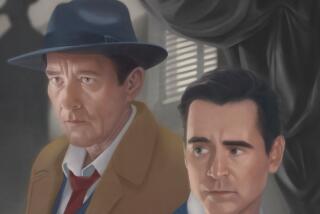Review: ‘Searching for Sugar Man’ is a sweet mystery
You never know where social resistance will find its prophets and poets. For young liberal Afrikaners opposing apartheid in the ‘70s, it was an unknown Detroit singer-songwriter named Rodriguez, the mysterious figure at the soulful center of the excellent new documentary”Searching for Sugar Man.”
As the story goes, a bootleg copy of the singer’s first album, 1970’s “Cold Fact,” made its way into South Africa. The powerful lyrics of repression and urban decay quickly caught on among the country’s disaffected youth. Rumors that a despondent Rodriguez had committed suicide onstage at the end of a performance, and the government ban on his music, only heightened his appeal. The album went platinum in South Africa and his legend grew. They say he was more popular than Elvis.
Years would pass until the persistence of an obsessive fan and the resourceful digging by music writer Craig Bartholomew-Strydom would lead back to Detroit, where Rodriguez’s story began. By now, the details of the story have long been public, yet you feel as if you are there as filmmaker Malik Bendjelloul sleuths out each clue to Rodriguez’s fate, resurrecting both the man and the music in the process.
The truth-is-stranger-than-fiction saga has been a hit on the festival circuit, winning top documentary prizes at Sundance forSweden’s Bendjelloul. What sets “Searching for Sugar Man” apart, though, is the way in which the filmmaker preserves a sense of mystery in the telling.
Bendjelloul begins in present day South Africa with Stephen “Sugar” Segerman, that obsessive fan. His nickname, and the documentary’s title, are both drawn from one of Rodriguez’s classic cuts, a haunting ode to a corner cocaine dealer called “Sugar Man.” Segerman’s “have you seen this man” milk carton-style plea via the Internet would ultimately play a key role in helping to crack the case.
While fans a half a world away were connecting with the work of the man his producers called a Chicano Bob Dylan, Rodriguez remained unknown in the U.S., dropped from his recording contract after his albums flopped and having returned to a blue-collar life of manual labor. For decades, the cerebral poet had no idea that on the other side of the globe, he was a rock superstar.
It was a juicy story that Bendjelloul, whose documentary TV work has long focused on rock music, was keen to tell. Still, the filmmaker had an interesting challenge in chronicling the life and unlikely stardom of Rodriguez.
Though the facts alone were compelling, there was almost no performance footage to work with, a central ingredient in most rock documentaries. The music, however, was there. The rustic folk-rock sound and politically provocative lyrics provide the seductive soundtrack for the film. They often serve as a stand-in for the artist as well. It is how we get to know him.
Bendjelloul fleshes things out by interviewing the well-connected music producers who first discovered him, convinced they had a sure thing. News footage of bloody Cape Town clashes between police and protesters in the ‘70s stands in stark contrast to shots of a decaying Detroit, factories closed, buildings boarded.
To deal with the early years, where there is no footage to be had, the filmmaker shifts between actual shots of the singer’s Detroit neighborhood and animation of those streets. Sketches he made of the lanky singer move slowly through the frame. The technique is handled with such subtlety that it is barely discernible when animation dissolves into reality.
It is a slow tease of a film, as Bendjelloul wends his way through the many myths and pieces together the reality. But finally, there is Sixto Rodriguez. A modest man of modest means, he quietly reflects on the success he now enjoys a continent away from his Detroit home and the hard times in between.
As it happens, the Rodriguez that Bendjelloul found is almost as elusive as the Rodriguez who was lost. Interviews with the artist and his family fill in many of the details of those missing years — the construction work he took on to pay the bills, the family he raised, the political activism he continued. But what shapes and drives his artistry remains just out of reach.
One of the most telling shots was taken on a winter day in Detroit. Rodriguez, wrapped in an old overcoat and wearing a fedora, is trudging through the snowdrifts, hunched against a bitter wind. There is no sense of what he is thinking or where he’s headed, only that he seems a man who knows exactly where he is going.
In “Searching for Sugar Man,” Bendjelloul has given us an indelible portrait of an artist given a second chance at fame.
More to Read
Only good movies
Get the Indie Focus newsletter, Mark Olsen's weekly guide to the world of cinema.
You may occasionally receive promotional content from the Los Angeles Times.











